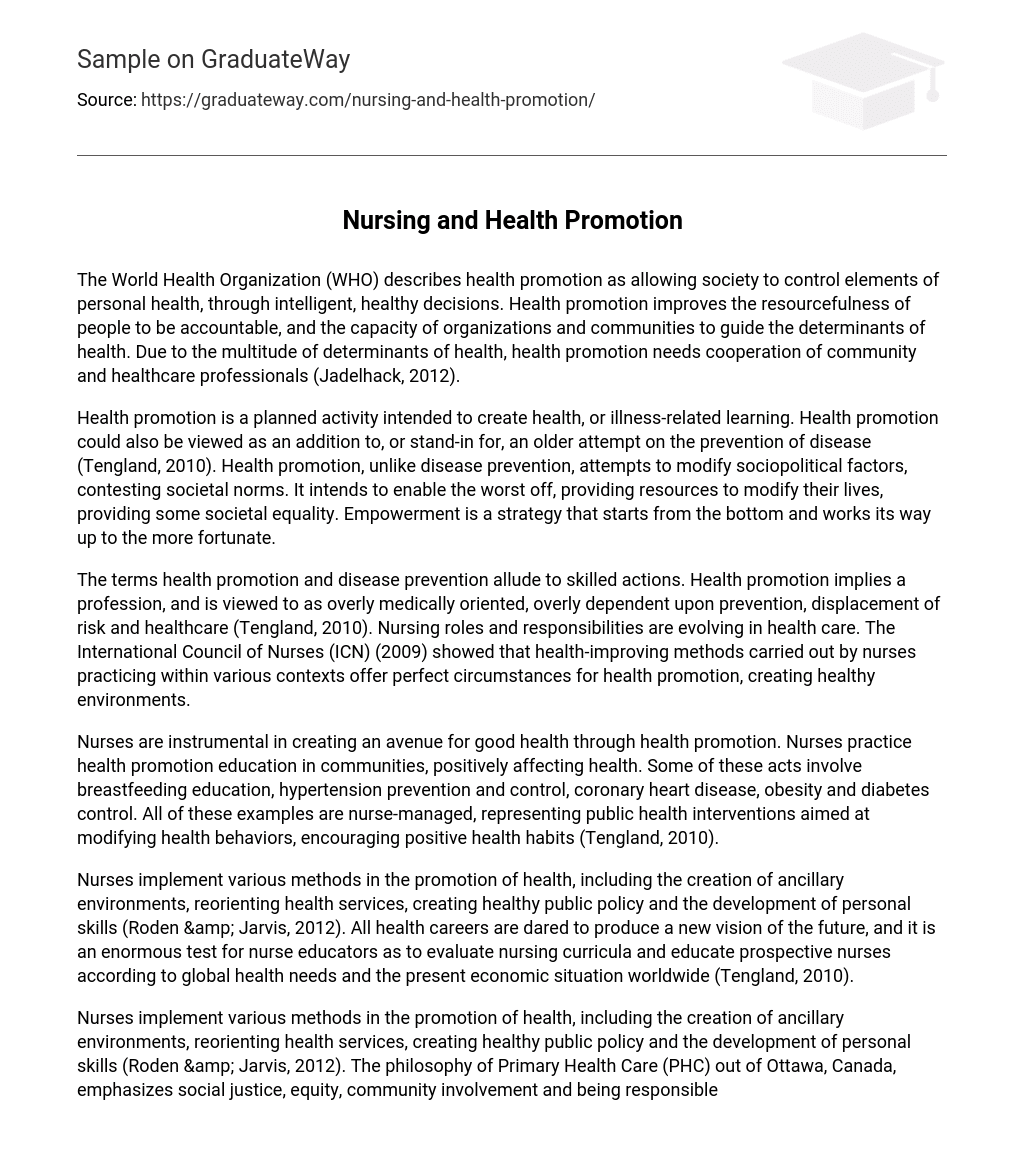The World Health Organization (WHO) defines health promotion as the act of aiding individuals and communities in making informed decisions for their health. The goal of health promotion is to empower people to take charge of their well-being, while also enabling organizations and communities to address all factors that impact health. Effective health promotion requires collaboration between healthcare professionals and the community due to the various influences on health (Jadelhack, 2012).
Health promotion, according to Tengland (2010), is a deliberate endeavor to raise consciousness and understanding about illnesses. It can be viewed as an expansion or alternative to prior attempts at preventing diseases. In contrast to disease prevention, health promotion seeks to challenge societal conventions in order to effect changes in social and political aspects. Its goal is to offer resources that empower disadvantaged individuals and enhance their quality of life, ultimately fostering equality in society. Empowerment adopts a grassroots approach that eventually encompasses even the more privileged segments of the population.
The concepts of health promotion and disease prevention are skilled actions, with health promotion being seen as a profession that is overly focused on medicine, prevention, risk displacement, and healthcare (Tengland, 2010). The roles and responsibilities of nurses in healthcare are changing. According to the International Council of Nurses (ICN) (2009), nurses in different settings have ideal opportunities to promote health and create healthy environments through various methods.
Nurses have a vital role in promoting good health by offering education and support in different community settings. They concentrate on important areas like breastfeeding education, hypertension prevention, coronary heart disease, obesity, and diabetes control. These initiatives, overseen by nurses, strive to alter health behaviors and encourage positive habits for the overall well-being of the public (Tengland, 2010).
Nurses employ different strategies to promote health, such as establishing supportive settings, reshaping healthcare services, advocating for healthy public policies, and enhancing personal skills (Roden & Jarvis, 2012). All healthcare professions are challenged to envision a new future, and nurse educators face a significant task of assessing nursing curricula and training future nurses based on global health demands and the current global economic climate (Tengland, 2010).
Nurses use a range of approaches to promote health, such as creating supportive environments, reorienting health services, shaping healthy public policies, and developing personal skills (Roden & Jarvis, 2012). The Primary Health Care (PHC) philosophy, developed in Ottawa, Canada, prioritizes social justice, equity, community engagement, and responsiveness to local needs in order to address health disparities. PHC aims to enhance individual and family health by providing accessible and sustainable healthcare services that empower individuals to live healthy and productive lives.
Nurses play a role in educating individuals, helping them develop personal skills to identify health risks (Roden & Jarvis, 2012). The three levels of health promotion prevention, including primary, secondary, and tertiary, differ significantly based on the severity of illness and irreversibility of the client’s condition. The first level focuses on maintaining the health of individuals with minimal instances of disease or injury. This level aims to reduce the likelihood of disease through preventive measures like immunization.
Primary prevention focuses on increasing societal resistance to diseases through methods such as immunization, eliminating health problem causes, and creating a health-friendly environment. At the next level, there are various cases ranging from health risks to severe illnesses. Providing medication to patients helps alleviate pain and decrease it. During this stage, the patient’s condition is stable. Lastly, tertiary prevention deals with the management of critical health conditions and chronic and communicable diseases. The spread of such diseases is troubling.
The concept of quarantine is crucial in preventing contagious diseases like AIDS. Disease-free zones are also important in containing the spread of diseases (Williams, 2011). Health promotion advocates need to be dedicated and skilled. It is essential for them to address various obstacles such as economic, political, religious, and regulatory barriers to promote healthy living. This requires overlapping goals, strategies, and competencies between health promotion, public health, and other health-related professions. Additionally, they must empower marginalized individuals to have a voice (Gould, Fleming & Parker, 2012).
Together with the assistance of other healthcare professionals, nurses can greatly impact healthy living by promoting health (Gould, Fleming, & Parker, 2012; Jadelhack, 2012; Roden & Jarvis, 2012).
The articles referenced are:
– “Contemporary Nurse: A Journal for the Australian Nursing Profession” (41(2), 271-284)
– “Health promotion or disease prevention: A real difference for public health practice?” by Tengland (18(3), 203-221, doi:10. 1007/s10728-009-0124-1)
– “Health promotion and disease prevention: Logically different conceptions?” by Tengland (18(4), 323-341, doi:10. 1007/s10728-009-0125-0)
The article titled “Primary prevention in health promotion” can be found on The Pulse website (www. FindArticles. com).





